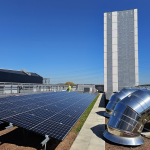This latest announcement of awards from Triple Point Heat Networks Investment Management demonstrates the incredible variety of projects currently under development across England. Today, we are delighted to share the detail of nearly £65 million to 5 projects; The London Borough of Brent, Old Oak and Park Royal Development Corporation (OPDC), Watford Community Housing Trust, GTC Infrastructure Limited and Lancaster University.

Ken Hunnisett, Programme Director for Triple Point Heat Networks Investment Management, said:
The ever-increasing data requirement of our interconnected world means that data centres are growing in number and capacity on an almost daily basis. It’s super exciting to see one of our investee networks recognise the potential of the waste heat generated by those data centres to warm the homes and buildings of the communities in which they’re located.
When built and commissioned, the projects subject of this latest announcement will deliver significant volumes of low-carbon, cost-effective heat to more than 14,000 homes in public and private ownership while also decarbonising an entire university campus for Lancaster’s 13,000 students.
Lord Callanan, Minister for Energy Efficiency and Green Finance, said:
Keeping homes warm with waste heat from technology is a glimpse into the future – and demonstrates just how innovative this country can be when it comes to reducing our carbon emissions.
The £65 million we’ve awarded today will help spread this success across the country, by rolling out innovative low-carbon heating to help to drive down energy bills and deliver our net zero goal.
The following projects have secured nearly £65 million to support the commercialisation and construction of low carbon networks across the country. These networks will use a range of technologies to deliver affordable heating and hot water to homes and businesses.
London Borough of Brent
In North London, £5.2 million of funding secured by the London Borough of Brent will enable local regeneration. The initial phase (1.2GWh) of the South Kilburn District Heat Network will supply low carbon heat using air source heat pumps combined with back up gas boilers. The heat pumps will be located on the rooftop of an existing property and will supply heat to 34 sites via a 2.79km pipe network, providing heating to 2,900 customers. The scheme has been future-proofed to enable additional growth of the network, with subsequent phases being delivered through the addition of a second energy centre.
Councillor Shama Tatler, Cabinet Member for Planning, Regeneration and Growth, said:
Regeneration across the borough is about bringing opportunities, growth and jobs to the local population. We always put the environment at the heart of our projects and the South Kilburn District Heat Network is a great example of that, creating low carbon heat for over 34 sites, as well as being future proofed so that we can increase the network to other homes in the future.
Old Oak and Park Royal Development Corporation (OPDC)
In the heart of West London, GHNF is unlocking waste heat from data centres by awarding £36 million to the Mayor of London’s Old Oak and Park Royal Development Corporation (OPDC) for commercialisation and construction of the district heat network. The innovative project is the first of its kind to secure GHNF support, with the cooling of data centres offering a predictable supply of low-grade heat to distribute to a number of energy centres via a plastic “ambient” network. The ambitious project will offer unrivalled connectivity for thousands of new and affordable homes, businesses and services in the area. The OPDC area spans three London Boroughs in the largest adopted Opportunity Area in London. Heating will be delivered to over 10,000 homes and 250,000m2 of commercial space, all the while creating 22,000 new jobs.
Due to the scale and innovative nature of the project, the Mayor of London’s Local Energy Accelerator (LEA) funding programme, which was co-funded by the European Regional Development Fund, has also provided almost £400,000 to fund technical expertise to develop the OPDC-led heat network.
David Lunts, OPDC Chief Executive says:
Recycling the huge amounts of wasted heat from our local data centres into heat and energy for local residents, a major hospital and other users is an exciting and innovative example of OPDC’s support for the mayor’s net zero ambitions.
We are excited to be leading the way in developing low carbon infrastructure, supporting current and future generations of Londoners in Old Oak and Park Royal to live more sustainably.
Watford Community Housing
GHNF funding has also been awarded in South-West Hertfordshire. Watford Community Housing, a not-for-profit housing association with approximately 5,700 homes, will receive £1.8 million of funding to replace an old gas district heating system. To deliver its decarbonisation targets in one community, Watford Community Housing has decided to install a district heating scheme using a ground source heat pump (GSHP). The scheme will provide affordable, low carbon heat to residents in 252 apartments across 6 blocks. Watford Community Housing has demonstrated commitment to renovating properties across its portfolio and the £1.8 million of funding will allow the housing association to replace an old gas district heating system which was built in the 1960s and is economically unviable, with a new, highly efficient one.
Helen Town, Group Director of Property and Partnerships at Watford Community Housing, said:
Watford Community Housing is delighted to be taking part in the Green Heat Network Funding programme. This will enable us to bring in a renewable energy alternative to a dated district gas heating system. This will make a real difference to residents and is part of our wider commitment to promote the decarbonisation of our homes and affordable warmth for our customers.
Chilton Woods – Suffolk
A Taylor Wimpey development at Westland Heath in Suffolk has been designed to incorporate a community heat hub which is able to provide low/zero carbon heat to family housing developments. The scheme is a result of extensive development work by GTC, Metropolitan and Taylor Wimpey and is expected to become a standardised GTC offering which can be used across the housebuilding industry high quality, fossil-free heating.
The community heat hub has been designed to provide heat to up to 950 residential connections and a primary school, and the initial spine network has already been constructed. The Green Heat Network Fund (GHNF) award of £745,000 will enable the completion of the heat hub and installation of air source heat pumps (ASHPs). The flexibility of a heat network is a key benefit of this approach over the installation of individual heat pumps in the homes as it will allow technological improvements without disruption to consumers. Moreover, the use of a thermal store will provide demand side response services to National Grid ESO and local District Network Operators (DNOs). This approach is expected to be rolled out across numerous new build GTC sites, equating to 95,000 homes.
Andrew White, Metropolitan Managing Director commented:
We are really excited to be able to welcome new customers on our newest zero carbon heat network at Taylor Wimpey’s Westland Heath development. This is the culmination of several years of collaboration between GTC, Taylor Wimpey and Metropolitan and will showcase how new build development can help the UK in reducing its carbon emissions. Our network solution is already better value for house builders and homeowners, compared to each house owning a heat pump.
The exciting thing is that our solution provides valuable services to enable a smarter electricity grid. The central Heat Hub provides a single exit from the electricity grid. We use thermal stores to reduce grid connection capacity and can add a battery to reduce this further. And we use this demand side response to create more value from grid wholesale and balancing, which will reduce homeowner bills further.
Lancaster University
In addition to the above, a second university will benefit from low carbon heating under GHNF, with Lancaster University securing over £21 million to help the institution achieve a Net Zero future through an innovative heat network. Lancaster University, ranking 24th for sustainability in the 2024 QS World University Ranking and 5th in the UK, is set to fully decarbonise its campus with a low carbon energy centre. The centre will use air source heat pumps, thermal storage and electrical infrastructure works, providing 45 GWh of low carbon heat sufficient to provide heating and hot water for virtually all of the campus.
Since declaring a climate emergency in 2020, Lancaster University has placed carbon neutrality at the centre of its Estates Strategy with a number of initiatives including the University’s “Heat Pump Ready Buildings” programme. The heat pumps will be supplied by renewable electricity from a new solar farm and an existing wind turbine, providing a low carbon solution for heat and electricity supply to the whole campus for the next generation. The project will see consumption of gas for heating substantially eliminated. The University will also develop a living lab research hub and a campus decarbonisation showcase facility.
Professor Simon Guy, Pro-Vice-Chancellor Global Digital, International, Sustainability at Lancaster University said:
Lancaster University has a long-established reputation for its world-leading education and research. With this next step, Lancaster aims to be among the best in the world for offering students and staff a sustainable and carbon neutral campus in which to work and study.
Our students want to go out into the world to make a difference – what better start to that ambition than a world-class university education which is mindful of the planet and places sustainability at the heart of its decision making.
Notes to editors:
For all media enquiries, please contact: comms@tp-heatnetworks.org.
The Green Heat Network Fund (GHNF) is a multi-year, capital grant fund that opened to applicants in March 2022 and is anticipated to run to 2027. It will provide support to organisations in the public, private, and third sectors in England. The GHNF is a key part of plans to reduce carbon emissions from heating homes and businesses by 2050. It replaced the Heat Networks Investment Project (HNIP) scheme which closed for applications in January 2022. In contrast to the HNIP scheme, the GHNF scheme will only fund heat network projects where there is a low-carbon heat source.
For more information about Triple Point Heat Networks Investment Management, applying for GHNF support, successful projects under GHNF and HNIP, and BHIVE, visit: www.tp-heatnetworks.org.
A high-level summary of GHNF https://www.gov.uk/government/publications/green-heat-network-fund-ghnf
For further information about the scheme and to join the TP Heat Networks mailing list to receive updates, please contact us: enquiries@tp-heatnetworks.org.



